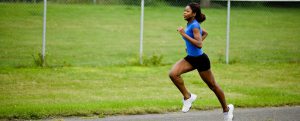 As we learn more about the benefits of school gardens and farm-to-school programs, we need to ensure that we do not gloss over the food safety aspect. Many people are utilizing local farmers or their own school gardens to provide food in their school cafeterias or salad bars, so they need to think about the steps involved to prevent the students from getting any food-borne illness. This webinar did a great job of outlining the different ways health professionals can maintain food safety while utilizing a farm-to-school program.
As we learn more about the benefits of school gardens and farm-to-school programs, we need to ensure that we do not gloss over the food safety aspect. Many people are utilizing local farmers or their own school gardens to provide food in their school cafeterias or salad bars, so they need to think about the steps involved to prevent the students from getting any food-borne illness. This webinar did a great job of outlining the different ways health professionals can maintain food safety while utilizing a farm-to-school program.
It is important to ensure that all local partnerships are with farmers that have good food safety practices to reduce risk. Some farmers may already have completed training or a certification, for example Vermont has a Practical Produce Safety certification that farmers can obtain. If you are not currently buying from a local vendor, you can encourage your vendor (who is likely to have a certification) to make purchases from a local farmer. In lieu of a certification, you can complete on-farm checklists that are provided by Iowa State University or the Institute for Child Nutrition. By going to the farm, you can check their practices yourself and develop trust with the farmer. When you are on the farm, it is important to inspect the incoming product and check the transporting vehicle to ensure that it is clean, to prevent any contamination.
Another way to maintain food safety is to keep records of where you get produce from. Traceability, knowing where your food is coming from and where it is going to, to very important to quickly identify any source of contamination. Even if it is a handwritten receipt from a vendor, it is better than no record at all.
Lastly, some schools utilize their school garden produce for their cafeterias or in their salad bars. In order to do this, ensure that all components of the process are safe, including but not limited to, clean water, proper composting, animal prevention, and safe produce handling. When you utilize food from the garden, store it in a separate container to maintain traceability. School salad bars are a great way to incorporate local produce and provide education to the students, and it should be treated like any other salad bar (proper temperature, tongs for serving, and clean area).
Overall, farm-to-school programs are a great way to get local produce into the schools, but it is important for health professionals to maintain proper food safety across all aspects of the food procurement process to prevent illness. Also, food safety may be a great learning avenue for the students to start implementing safe practices. Innovation is the key here, because farm-to-school programs have so much potential.
 Farm-to-School programs are great for helping children and youths learn more about healthy eating. However sometimes after everything is going smoothly, there is a point where funding levels or community interest decreases. There a few solutions that a Farm-to-School program in Burlington, Vermont have implemented to overcome these barriers and expand their program. They have shared their solutions in a USDA webinar as a way to help others create their own sustainable programs.
Farm-to-School programs are great for helping children and youths learn more about healthy eating. However sometimes after everything is going smoothly, there is a point where funding levels or community interest decreases. There a few solutions that a Farm-to-School program in Burlington, Vermont have implemented to overcome these barriers and expand their program. They have shared their solutions in a USDA webinar as a way to help others create their own sustainable programs. urlington
urlington Technology is such a great tool. So many people are using for health reasons, by tracking their food consumption, their physical activity and daily steps, or even their sleep quality. It is truly the way of the future. So, when Pokémon Go, a gaming app, was released and the craze began getting people off their couches to “catch” Pokémon, many people wondered how this could be helpful for the obesity epidemic.
Technology is such a great tool. So many people are using for health reasons, by tracking their food consumption, their physical activity and daily steps, or even their sleep quality. It is truly the way of the future. So, when Pokémon Go, a gaming app, was released and the craze began getting people off their couches to “catch” Pokémon, many people wondered how this could be helpful for the obesity epidemic. There are a few different types of bariatric surgery methods. The most common is the Vertical Sleeve Gastrectomy. In this method, 80% of the stomach is removed. Another method is the Roux en Y method. This used to be the most common, however, this is becoming less popular. This method bypasses the duodenum and creates a 30-mL (1/2 to 1 oz) stomach.
There are a few different types of bariatric surgery methods. The most common is the Vertical Sleeve Gastrectomy. In this method, 80% of the stomach is removed. Another method is the Roux en Y method. This used to be the most common, however, this is becoming less popular. This method bypasses the duodenum and creates a 30-mL (1/2 to 1 oz) stomach.
